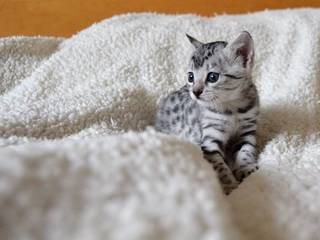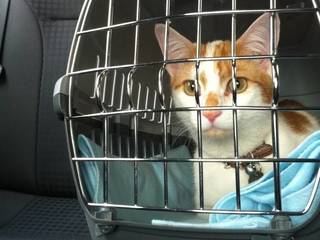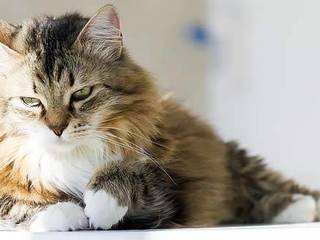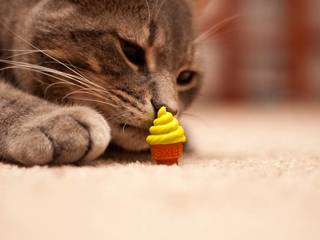The process of getting a new kitten is so exciting. But picking out the right kitten for you can seem a little intimidating at first. No doubt they are all incredibly cute, but their personalities can be very different! Thankfully, there are so many amazing breeds available that you'll be sure to find your perfect match. If you live in an apartment, you'll also have to take some other factors into consideration when choosing your kitten. Are the walls pretty thin? If so, you might want to choose a breed of cat that is on the quieter side. Are you going to be home much? If yes, you'd be okay to get a kitten that craves human attention, but if not, you may want to consider a more independent breed. But not to worry, we'll cover a few of the different breeds that make some of the best kittens for apartments.
Here are some of the key things to consider when looking at a kitten or breed:
Size: It is important to consider size when thinking about what kind of kitten you are going to bring home. Typically, smaller-sized cats make the best cats for apartments, but some larger cats can also do well.
Energy level: When considering bringing a kitten into your apartment, consider their energy level. More laid-back and calm kittens make for great roommates in an apartment. Those with high energy may just keep you up all night with their running from the bedroom to the living room at 3 AM!
Noise level: Most cat breeders would agree that some kittens are known to be quite a bit more vocal than others, so you may want to consider a breed that is known for being on the quieter side if you have neighbors close by or thin walls. While cats aren't inherently loud animals, some breeds have a propensity for "yelling" their demands at you.
Maine Coon

Maine Coons are large and friendly cats with thick, long coats. Despite their large size, they can do quite well in an apartment setting so long as they have a way to get their mental stimulation needs and physical exercise requirements met. They are highly intelligent and playful, so plenty of toys, scratching posts, and room to exercise will be a must. They are often considered great family pets as they get along well with children as well as other pets.
British Shorthair

The British Shorthair is a compact, stocky-looking cat with a quiet, gentle nature. They are known for their round faces and thick, plush coats, which come in a wide variety of colors and patterns. Most commonly seen, though, is a coat with a gray hue. British Shorthairs are generally low-maintenance cats and are easy to care for. They are a relatively healthy breed and do not require a lot of grooming, although their thick coats should be brushed regularly to prevent matting. British Shorthairs are known for their love of people and attention and their calm, laid-back personalities, making them a popular choice for people who live in apartments or small homes.
American Shorthair

The American Shorthair is a breed of domestic cat believed to be descended from European cats brought to North America by early settlers. These settlers needed help protecting their valuable cargo and food from mice and rats. The breed is known for its sturdy, muscular build and its short, thick coat. Like their British cousins, their coats can be made up of a wide variety of colors and patterns. American Shorthairs are generally considered to be easygoing, gentle cats with calm personalities, and they are well-suited to life in a variety of environments, including urban apartments and rural homes. They are generally good with children and other pets and are known for their affectionate, loyal nature.
Norwegian Forest Cat

The Norwegian Forest cat is a large, rugged breed of domestic cat that is native to Norway. It is known for its long, thick coat, which is specially adapted to withstand cold temperatures. The breed has a strong, muscular build and a triangular-shaped head. They are known for their intelligence and playful personalities. Norwegian Forest cats are also known to be good climbers and are generally good with children and other pets. They are a popular breed in Norway and are quickly gaining popularity in other parts of the world as well. While they seem to be designed to withstand life outdoors thanks to their rugged nature and long, thick coats, Norwegian Forest cats can still enjoy life indoors and in apartments.
Sphynx

The Sphynx breed of cat is a breed of hairless cat known for its unique appearance and friendly personality. These cats are known to be intelligent, curious, and affectionate. They are typically quite calm cats but do have a friendly and playful side to them as well, so they do quite well living in apartments. Despite not having any fur, they are one of the more high-maintenance breeds of cats. While other cats may need frequent brushing, the Sphynx needs frequent baths! The usual recommendation is to give a Sphynx a bath about once per week. Because they don't have fur, their skin can easily build up with excess oils, which can lead to problems later on. In addition to baths, it's important to limit the amount of time these cats spend in the sun to avoid damage to their skin. They are also more prone to be cold, so it's likely that they will prefer to wear sweaters in the colder months!
Devon Rex

The Devon Rex is a breed of cat known for its short, curly coat and large, expressive eyes. These cats are playful, energetic, and fun-loving. More than that, they are often described as affectionate and loyal. They are intelligent and curious and enjoy interacting with their human companions and other pets in the household. Despite their small size, Devon Rexes are athletic and enjoy climbing and playing. They can do well in apartments, but adding vertical climbing spaces may be helpful since floor space is limited in these living spaces. Devon Rexes are generally healthy and hardy, with a lifespan of around 12-15 years.
Scottish Fold

The Scottish Fold is a breed of domestic cat with a distinctive fold in its ears. The breed originated in Scotland, thanks to a white barn cat named Susie. Susie was found in 1961 on a farm near Coupar Angus in Perthshire, Scotland. Susie had naturally folded ears, and when she had kittens, some of them also had folded ears. The breed was developed from Susie and her descendants, and it was officially recognized by cat fancy organizations in the 1970s. Scottish Folds are known for their sweet, gentle temperament and their affectionate nature. They are often described as being playful and intelligent, and they are known to be good with children and other pets. They are generally medium-sized cats with a short to medium-length coat that can be a variety of colors and patterns. Scottish Folds are generally healthy and have a lifespan of around 12-14 years.
Persian

Persian cats are a beautiful long-haired breed of cat characterized by their round faces and short muzzles. They are known for their calm, gentle personalities and are often a popular choice for families with children and other pets. Persian cats are one of the oldest breeds of cats. Most believe they originated in Iran. However, their exact origins are not known. They are medium to large in size, with a short, stocky build and long, thick fur. Persian cats come in a wide range of colors, including white, black, blue, red, cream, and silver. They are fairly high maintenance due to the fact that their long and lush coat will need frequent brushing to ensure no knots, tangles, or mats form.
Ragdoll

Ragdoll cats are a breed of domestic cats well-known for their relaxed and easygoing temperament as well as their stunning looks. Many believe they were named "Ragdoll" because of the way they often simply go limp in your arms when you pick them up. They are a relatively new breed, having only first been developed in the 1960s. Ragdolls are on the larger side of the spectrum for cat breeds and have a semi-long, silky coat that comes in a variety of colors, including seal, blue, chocolate, and lilac. They are known for their stunningly bright blue eyes and large, almost rabbit-like paws. Ragdolls are known for being very affectionate and loyal to their owners. They are generally good with children and even with other pets in the home. Overall, they make excellent, loving companions. They are not particularly active cats and tend to be more laid back and relaxed, so they often do very well in apartments. Chances are, they'll be happy to snuggle up with you on the couch!
Birman

Birmans are a domestic cat breed known for their long, silky fur and striking blue eyes. They are similar in appearance to Siamese cats but are larger in size with a sturdy, muscular build. Birmans are known for their gentle and calm personality and are very social and affectionate with their families. They also get along well with children and other pets thanks to their even and patient temperament. They also are quite intelligent and can be trained to do all sorts of tricks. Although they do like their independence sometimes and are quite content to spend some time alone, Birmans do love spending quality time with their owners. They are generally healthy and can live for anywhere from 15-20 years. Though large in size, they do not require a lot of space to run and play as they are not as active as some other breeds and instead are often perfectly content lounging around the house.
Cornish Rex

The Cornish Rex is a breed of domestic cat with a narrow head and almost comically large eyes and ears. They have a slender and athletic build which helps them immensely when they are busy romping around and playing! Originally developed in Cornwall, England, this breed is known for its playful and energetic personality. They are also intelligent and can learn any number of tricks. Cornish Rexes are generally good with children and other pets, and they tend to bond closely with their owners. Overall, the Cornish Rex is a unique and affectionate breed that makes a great companion for many different types of households, including apartments.
Munchkin

Munchkin cats are well known for their short legs, which are the result of a naturally occurring genetic mutation. They were originally discovered and then purposefully bred in the UK in the 1940s. Despite their unusual appearance, Munchkins are just as healthy and athletic as cats with normal leg length. They are affectionate and playful and can easily adapt to any living situation. Munchkins come in a variety of colors and patterns and have short to medium-length coats that are easy to groom. They are generally good with children and other pets and make loyal and loving companions. They are quite entertaining, too, in that they often like to sit on their hind legs like rabbits!
Tonkinese
The Tonkinese breed of cat is a cross between the Siamese and Burmese breeds. The breed was created by breeding Siamese cats with Burmese cats in order to create a cat that combined the best traits of both breeds. The resulting cats have a body type and coat that is similar to the Siamese but with a softer, more moderate facial structure and a wider range of coat colors. Today, the Tonkinese breed is popular in many countries around the world.
They are known to be very energetic and playful and enjoy engaging in activities such as chasing toys and playing with their human companions. In addition to their playful nature, Tonkinese cats are also known for their intelligence and curiosity, which can sometimes get them into mischief. They are athletic animals and love to run, jump, and play, so it is important to provide them with plenty of toys and activities to keep them entertained.
Turkish Van
The Turkish Van is a breed of cat native to the Lake Van region of Turkey. They are known for their distinctive "van pattern" coat, which is mostly white with colored markings on the head and tail. The breed is also known for its love of water and is often referred to as the "Swimming Cat." They will sometimes even try to take a dip in your bath! Turkish Vans are medium to large in size and are known for their athletic, muscular bodies. They are intelligent and playful cats, and they are very good climbers. They love to be up high and to watch everything going on below them. They are also social animals and enjoy the company of humans and other animals. They aren't known for being the most patient cat with young children who don't know better than to pull on a cat's tail, though, so they may do best with families with older children. One of the most distinctive features of the Turkish Van is its coat. The breed is known for its long, silky fur, which is generally white with darker-colored markings on the head and tail. Turkish Vans are generally healthy and hardy cats with a lifespan of around 13 to 17 years. They are known for being low-maintenance pets, requiring little grooming beyond the occasional brushing to keep their fur looking silky.
Oriental
The Oriental cat is a breed of domestic cat that is known by its slender body, long legs, long tail, wedge-shaped head, and large, pointed ears. They are known for their energetic and playful personalities and are often described as being dog-like in their loyalty and affection towards their owners. Oriental cats come in a wide range of coat colors and patterns, including solid, tabby, tortoiseshell, and calico. There are both shorthair and long hair Oriental cats, both of which have soft and silky fur. These cats do require regular grooming to keep their coat in good condition, especially if they have a long coat.
Egyptian Mau
The Egyptian Mau is a beautiful and graceful breed of domestic cat. It is believed to be one of the oldest natural breeds of cats. A native to Egypt, it was once revered as a sacred animal. The Egyptian Mau is known for its striking appearance, with a short, sleek coat that comes in a variety of colors, including silver, bronze, and black. One of the most distinctive features of the Egyptian Mau is its eyes, which are large, round, and expressive, made even more distinctive by "mascara" lines around the eyes. They are also known for their distinctive "meow," which is said to sound much like a chirping bird. They are known for their athleticism and for how much they love to play. And they are also quite intelligent and curious, so they will need plenty of stimulating toys and enriching activities to keep them busy. They are generally friendly and social, and they get along really well with children and other pets as they thrive on getting plenty of attention and interacting with their families.
Turkish Angora
The Turkish Angora is a breed of domestic cat that is famous for its long, silky hair. The breed originated in Turkey, and it has been known in Europe since the 16th century before making its way to other parts of the world. Angora cats are known for their playful, energetic personalities and their affectionate nature. They are intelligent cats and are quite easy to train. They are also known for their distinctive appearance, with long, fine fur and an elegant, slender build. They come in a variety of colors, including white, black, blue, red, and cream. Deafness is a genetically passed down trait that seems to affect many Turkish Angoras. For the most part, though, they lead just as healthy of lives as their hearing counterparts. Though they love their owners, they usually do just fine when they have to be left home alone for a while. Just be sure to have some scratching posts around in case they get bored while you are away! It is also important to note that the Turkish Van and the Turkish Angora, while they do share a common lineage, they are their own distinct breeds, genetically speaking.
Bombay
The Bombay breed of cat is a breed of domestic cat that is characterized by its sleek, black coat and copper eyes. The breed was created in the 1950s by a breeder named Nikki Horner, who wanted to create a breed of cat that resembled the black panther. Bombay cats are known for their affectionate and social nature. They are intelligent and easily trainable, but they do have a strong hunting instinct, so they may not be well suited for homes with smaller pets like hamsters, gerbils, or mice. Bombay cats are overall healthy cats and typically have a lifespan of around 15 years. They are an excellent choice for people who are looking for a loyal and loving companion.
American BobTail
The American Bobtail is a breed known for its short, "bobbed" tail. These cats are generally muscular and athletic, with a medium to large build. In addition to their uniquely short tails, they also have a distinctive appearance, with a wide head, large ears, and almond-shaped eyes. American Bobtails are intelligent, curious, and playful, and they are known to be good problem-solvers. American Bobtails are also known to be very vocal and may "talk" to their owners frequently. They are also good with children and other pets. Luckily for apartment dwellers, American Bobtails generally seem pretty good about only talking with their "inside voices" and don't have a tendency to meow or scream obnoxiously. Instead, they like to communicate with meows, purrs, and quiet chirps.
Conclusion
As you can tell by this extensive list, there are nearly endless options for kitten breeds that do very well living in apartment settings! The most important things to consider are size, energy level, and noise level when choosing the best kitten for an apartment. Also, consider how much time you have to spend at home with your kitten, as some kittens really love the company of their humans.
FAQ
Will house cat survive outside?
It depends on various factors such as the environment, availability of food and water, weather conditions, and the cat's ability to defend itself against potential predators. While some cats are skilled at hunting and may be able to find food, they can also be exposed to diseases, parasites, and injuries that could be life-threatening. Domesticated cats may also lack the natural instincts and behaviors necessary for survival in the wild, which could make it more difficult for them to adapt to life outside.
Apartment cat tips
Here are some tips for keeping a cat happy and healthy in an apartment: Provide plenty of vertical space: Cats love to climb and explore, so make sure there are plenty of places for your cat to climb and perch. You can install shelves, cat trees, or window perches to give your cat vertical space to play and rest. Keep litter boxes clean: It's important to keep your cat's litter box clean to prevent odors and maintain your cat's hygiene. Scoop out the litter box daily and change the litter completely once a week. Provide plenty of toys and scratching posts: Cats need mental stimulation and exercise to stay healthy and happy. Provide your cat with a variety of toys, such as interactive toys and puzzle feeders, to keep them entertained. Scratching posts are also essential to prevent your cat from scratching your furniture. Create a comfortable sleeping area: Cats love to sleep in cozy and comfortable places. Provide your cat with a soft and warm bed or blanket in a quiet area of your apartment. Keep your cat entertained: When you're not home, provide your cat with entertainment such as a TV or radio playing soft music, or consider getting another cat for company. Provide a balanced diet: Feed your cat a balanced and healthy diet that meets their nutritional needs. Consult with your veterinarian for recommendations on the best food for your cat. Keep your cat up to date on vaccinations and checkups: Regular veterinary checkups and vaccinations are essential to keep your cat healthy and prevent illnesses.
How to cat proof apartment balcony?
some tips for cat-proofing your balcony: Install a cat-proof mesh: Install a mesh or netting around the balcony to prevent your cat from jumping or falling off. Make sure the mesh is securely attached to the balcony railing and floor. Use plexiglass or plastic sheets: If mesh isn't feasible or visually appealing, you can consider using plexiglass or plastic sheets to cover the balcony railing. This will prevent your cat from slipping through or getting stuck in between the railing. Provide a designated play area: Create a designated play area on the balcony with a cat tree, scratching posts, and toys. This will give your cat a space to play and relax while also keeping them away from the edges. Use plants with caution: Some plants can be toxic to cats, so be careful when selecting plants for your balcony. Research which plants are safe for cats and avoid any that could be harmful. Supervise your cat: Always supervise your cat when they are on the balcony. Do not leave them unattended, especially if they are not used to being on the balcony.






